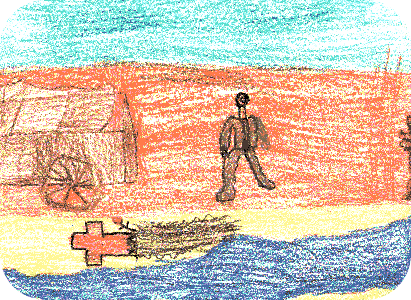Heritage Gateways
Official Sesquicentennial K-12 Education Projectsponsored by the Utah State Board of Education, the BYU-Public School Partnership and the Utah Education Network
Life On The Trail
Come, Come Ye Saints - Composed

Image courtesy of: Heritage Gateway Project Images, These images have been gathered to support the Sesquicentennial celebration of the immigration to Utah.
It was here on April 14th that a courier arrived with a letter from Nauvoo informing William Clayton, the camp clerk, of the safe birth of a son. (Many pregnant women were left behind in the relative safety of Nauvoo until the advance company of pioneers worked out the best way to travel from the Mississippi to the Missouri. Messengers were frequently sent back to help guide the other Mormons who went west in 1846.) The next morning, walking off by himself, he wrote in joy and gratitude the words of the now-famous hymn "Come, Come, Ye Saints," often called, with some justification, the "Mormon Marseillaise" or the "hymn heard around the world." The verses epitomized the Mormon motivation for going west and their experience on a dozen trails, some well known, some totally forgotten, between New York and Utah from 1831 to the completion of the transcontinental railroad in 1869.
Source: Historic Resource Study - Mormon Pioneer National By Stanley B. Kimball, Ph.D., May 1991. (The study focuses on the history of the trail from its official beginning in Nauvoo, Illinois, to its terminus in Salt Lake City, Utah, during the period 1846-1869. During that time, thousands of Mormon emigrants used many trails and trail variants to reach Utah. This study emphasizes the 'Pioneer Route' or 'Brigham Young Route' of 1846-1847. The sections on Mormon beliefs and motivations for going west have been omitted. Interested persons can find ample sources for that information. The footnotes, bibliography, maps, pictures, pioneer companies by name and dates for the 22-year period, and historic sites - about 2/3 of the book - have also been left out for space considerations. Thanks to Dr. Kimball and the National Park Service for the availability of this information.)